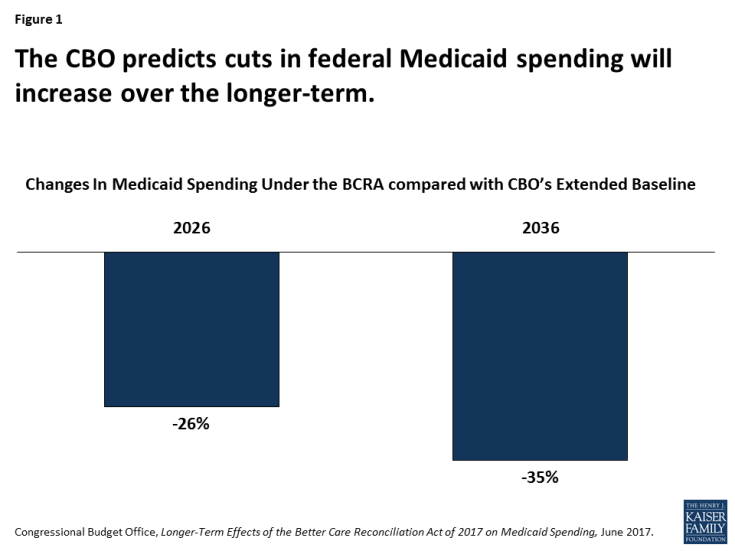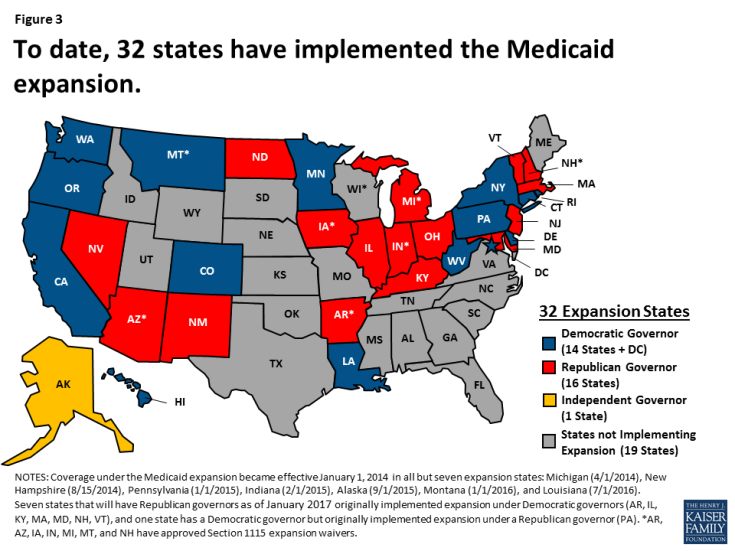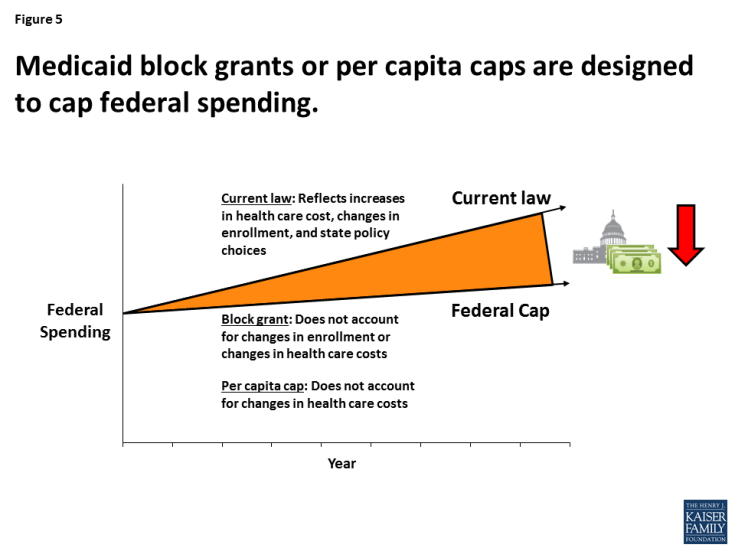Medicaid Changes in Better Care Reconciliation Act (BCRA) Go Beyond ACA Repeal and Replace
The Senate released an updated discussion draft of legislation called the Better Care Reconciliation Act of 2017 (BCRA) on July 20, 2017. For Medicaid, the overall framework is very similar to earlier versions of the bill in the Senate as well as the American Health Care Act (AHCA) that passed in the House. Both the BCRA and the AHCA go beyond repeal and replacement of the Affordable Care Act (ACA) to make fundamental changes to Medicaid by setting a limit on federal funding through a per capita cap or block grant. The BCRA also includes additional changes that would further reduce federal spending for states with high per enrollee spending, limit state financing mechanisms, allow states to impose work requirements, and make other eligibility changes. The revised draft of the BCRA leaves many provisions up to HHS Secretary discretion, creating further uncertainty for states about how implementation of the legislation would proceed. Across the board, these changes would have significant implications for the 74 million people covered by the Medicaid program and for states that jointly finance and administer the program.
The Congressional Budget Office estimates that under current draft of the BCRA, federal Medicaid spending related to the coverage provisions would decline by $756 billion over the 2017-2026 period or $739 billion accounting for all Medicaid provisions in the bill. According to CBO’s longer-term projections, the BCRA would reduce federal Medicaid spending by 35% in 2036 (Figure 1). These reductions would leave states with difficult choices about how to fill in the gaps in federal funding or cut back on Medicaid eligibility, benefits, or reimbursement rates (Figure 2). This brief explains the five most significant Medicaid changes in the BCRA as well as additional Medicaid changes that could have major implications for states, providers, and beneficiaries.
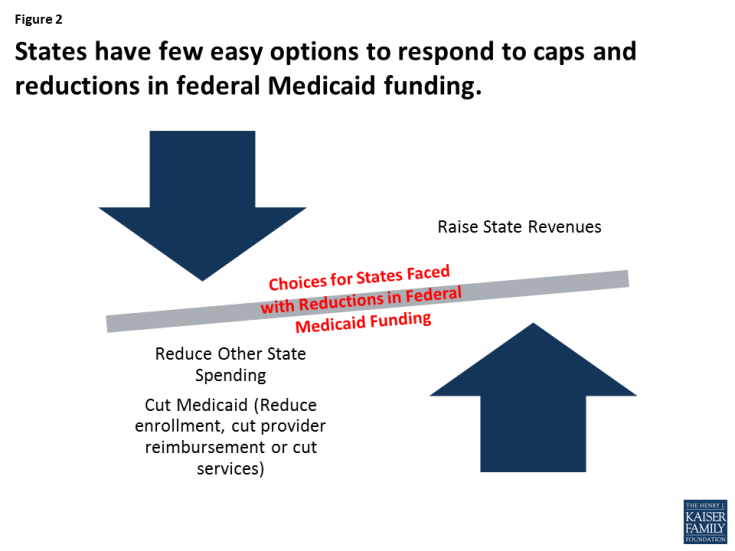
Figure 2: States have few easy options to respond to caps and reductions in federal Medicaid funding.
5 Most Significant Medicaid Financing Changes in the BCRA
Under the BCRA, for states that adopted the expansion as of March 1, 2017, the enhanced federal match would phase-out from 90% in CY 2020, to 85% in 2021, 80% in 2022, 75% in 2023 and then to the regular state match rate in 2024 and beyond. Thirty-one states plus DC have implemented the Medicaid expansion (Figure 3). On average, expansion enrollees account for 20% of all Medicaid enrollees (as of early 2016) and federal expansion financing accounts for about 21% of all Medicaid funding (for FY 2015). However, these shares are much higher in some states, placing them at higher risk for facing challenges in responding to the reduction in the federal match. Multiple states are likely to eliminate or scale back their expansion coverage due to the increased cost if federal funding is reduced, including eight expansion states (AR, AZ, IL, IN, MI, NH, NM, and WA) that have legislation requiring them to reduce or eliminate the expansion if the federal match rate is reduced. Given the magnitude of estimates of how much it would cost states to replace federal expansion funds, it appears that it is unrealistic to suggest that expansion states would be able to replace those funds and continue their expansion programs at current levels without the enhanced expansion match rate. Reports suggest that waivers or additional grant funding may be offered to states in place of the enhanced funding for the expansion, however, it is unlikely that such amounts would fully offset federal funding reductions in the BCRA tied to the expansion.
2. Limit federal Medicaid funding through a per capita, or per enrollee, cap on financing.
Under current law, Medicaid provides a guarantee of coverage for individuals who are eligible for the program and a guarantee to states of federal matching dollars for spending on Medicaid services. Beginning in FY 2020, the BCRA would limit federal Medicaid funding to each state based on the sum of the costs per enrollee for five beneficiary groups – elderly, blind and disabled adults,1 children, expansion adults, and other adults – multiplied by the number of enrollees in the group and the state’s federal match rate. The proposed legislation specifies a uniform national inflation factor for the federal financing growth rate. Under both AHCA and BCRA, the per enrollee amounts would increase annually at slower rates than projected growth for Medicaid (Figure 4).
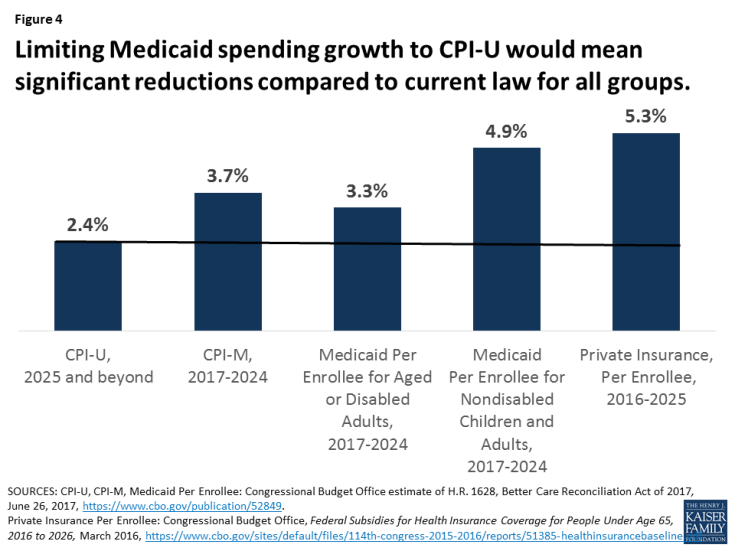
Figure 4: Limiting Medicaid spending growth to CPI-U would mean significant reductions compared to current law for all groups.
The caps are estimated to result in large reductions in federal Medicaid spending over time. Under BCRA, the caps would initially grow by the Consumer Price Index for medical care (CPI-M) for adults and children and by the CPI-M plus one percentage point for elderly and disabled groups. Starting in 2025, per enrollee amounts for all groups would increase by the historically lower CPI for urban consumers (CPI-U). All of these rates are lower than projected growth for private health insurance spending per enrollee. Reductions in federal Medicaid funding from the caps are expected to grow over time, especially after 2025 when the inflation factor is limited to CPI-U. Current projections have CPI-M growing at 3.7% and CPI-U at 2.4% annually; however, the rate of growth for these indices can vary and fluctuate over time which could cause uncertainty and instability in state budgeting.
The BCRA also includes a provision not included in the AHCA, which would direct the HHS Secretary to adjust target per enrollee amounts under the per capita cap to bring states closer to national average spending. Specifically, the Secretary would adjust a state’s target per enrollee amounts by 0.5% to 2% for states spending 25% or more either above or below the national average per enrollee expenditures beginning in 2020. These adjustments are applied to overall per enrollee spending in 2020 and 2021 and then for each enrollment group in subsequent years. Adjustments are to be budget neutral to the federal government (meaning they would not result in a net increase of federal payments under the per capita caps for the fiscal year). Certain states with population densities less than 15 individuals per square mile (currently: AK, MT, ND, SD, and WY) would be exempt from this provision. Data for 2014 show that the number of states with high per capita spending that face tighter caps exceeds the number of states that would experience relief for having low spending overall and for each eligibility group (Table 1). Secretary discretion and actual spending patterns will make it difficult for states to estimate the effect of this provision.
| Table 1: States Potentially Subject to Target Spending Adjustment Under the BCRA Based on FY 2014 Medicaid Spending Per Enrollee | ||||
| Group | States 25% or More Above U.S. Average Per Enrollee Spending |
States 25% or More Below U.S. Average Per Enrollee Spending |
||
| Total | 13 States | AK*, CT, DE, DC, MA, MD, MN, MO, ND*, NY, PA, RI, VT | 3 States | FL, NV, SC |
| Children | 11 States | AK*, AR, CT, DE, DC, MA, MN, ND*, NM, RI, VT | 5 States | FL, LA, NV, SC, WI |
| Adults | 17 States | AK*, CT, DE, DC, GA, KS, MD, MN, MT*, ND*, NE, OR, RI, TN, VT, VA, WA | 6 States | AR, CA, CO, FL, MA, NV |
| Disabled | 12 States | AK*, CT, DE, IN, MD, MN, ND*, NH, NY, RI, VT, WY* | 4 States | AL, GA, SC, WI |
| Aged | 20 States | AK*, CT, DE, DC, IN, IA, KS, MD, MA, MN, MO, ND*, NH, NY, OH, PA, RI, VT, WV, WY* | 8 States | AZ, CA, CO, GA, NJ, NC, SC, UT |
| NOTES: Per enrollee spending percentages based on full-benefit enrollees only. *States with a population density of less than 15 individuals per square mile are exempted from downward cap adjustments under the BCRA. According to the last census, the states that would currently be exempt are AK, MT, ND, SD, and WY. SOURCE: Kaiser Family Foundation estimates based on analysis of data from the 2014 Medicaid Statistical Information System (MSIS) and Urban Institute estimates from CMS-64 reports. http://www.kff.org/medicaid/state-indicator/medicaid-spending-per-full-benefit-enrollee/?currentTimeframe=0&sortModel=%7B%22colId%22:%22Location%22,%22sort%22:%22asc%22%7D |
||||
Beginning in FY 2020 under the BCRA, states could elect to receive federal financing for nonelderly/non-disabled traditional adults (low-income parents and pregnant women) and/or adults eligible through the ACA Medicaid expansion in the form of block grant instead of per capita cap funding. The block grant amount that states would receive from the federal government is initially based on the state’s target per capita spending amount for the fiscal year multiplied by the number of adult enrollees and the federal average Medicaid matching rate. The amount would grow annually by CPI-U even prior to 2025 when the per capita cap amounts would grow by the higher CPI-M inflation factor. States have a maintenance of effort (MOE) requirement—essentially, a minimum amount states must spend each year—that is the state share of the enhanced CHIP match rate (without the 23 percentage point increase provided under the ACA) multiplied by the block grant amount. If a state fails to meet the MOE requirement in a given year, its federal block grant amount for the following year would be reduced. States that meet MOE and continue to elect the block grant option can rollover unused block grant funds into the next fiscal year.
Under the block grant option, states could impose conditions of eligibility and not comply with key provisions in current law like comparability and state-wideness. Under the block grant option, states would be required to cover low-income parents and pregnant women at current federal minimum income levels and provide certain benefits. However, states could set conditions of eligibility for groups beyond these federal minimum groups, including for ACA expansion adults. Additionally, states electing the BCRA block grant option would not have to comply with other federal requirements, including comparability (the requirement that Medicaid-covered benefits be provided in the same amount, duration, and scope to all enrollees), state-wideness (the requirement that bars Medicaid programs from excluding enrollees or providers because of where they live or work in the state), and freedom of choice of provider (that allows beneficiaries to be permitted to choose among any provider participating in Medicaid). Like per capita caps, Medicaid block grants fail to account for changes in health care costs over time. Block grants also carry additional risk for states, providers, and beneficiaries because they do not account for changes in Medicaid enrollment (which could increase during an economic downturn) (Figure 5).
5. Provides the HHS Secretary discretion to allocate funds to address the opioid crisis and public health emergencies.
The BCRA appropriates $45 billion for FY 2018 through FY 2026 for grants to states to support substance use disorder treatment and recovery support services with significant discretion to the HHS Secretary to allocate the funds. The BCRA also provides the HHS Secretary with discretion to exclude from a state’s per capita cap or block grant limit a total of $5 billion across all states for Medicaid spending in response to a public health emergency from January 2020 through December 2024. This exclusion would only apply during a period in which the HHS Secretary has declared a public health emergency in a state or region and also deemed an exclusion appropriate. Under current law, states can increase spending with a guaranteed federal match or seek waivers (like in Flint, MI or for states hit by hurricane Katrina) to address public health emergencies.
Other Significant BCRA Medicaid Changes
Other BCRA Medicaid changes with significant implications for states, providers, and beneficiaries include the following:
Limiting states’ ability to use provider taxes to finance their share of Medicaid by lowering the provider tax safe harbor threshold2 from 6.0% to 5.0% of net patient revenues over 5 years, beginning in 2021. All states except for Alaska currently use provider taxes to finance the state share of Medicaid, and in 2016, 28 states had at least one tax exceeding 5.5% of net patient revenues. The proposed BCRA change could shift additional costs to states or result in additional reductions in Medicaid payment rates, services, or eligibility.
Creating a state option to require work as a condition of eligibility for nondisabled, nonelderly Medicaid adults as of October 1, 2017 (with some exemptions for certain groups including pregnant women or the sole caretaker of a child under age 6 or a child with a disability). Depending on how they are implemented, work requirements could increase administrative burdens on states and adversely affect some people, who are unable to comply due to their health, family caregiving obligations, or other reasons, by preventing them from accessing needed health coverage through Medicaid.3
Cancelling scheduled disproportionate share hospital (DSH) payment reductions for non-expansion (but not for expansion) states. The BCRA would exempt non-expansion states from the DSH reductions that were included in the ACA. During FY 2020-FY 2023, the BCRA would also provide a DSH payment increase to non-expansion states with per capita FY 2016 DSH allotment amounts (the FY 2016 DSH allotment divided by the number of uninsured individuals in the state for the fiscal year) that are below the national average per capita amount. A state qualifies as a non-expansion state if it is not covering expansion adults on or after January 1, 2021. This means that current expansion states that discontinue their expansions by the end of 2020 could qualify for increased DSH funds after their expansion ends. In addition, the BCRA would provide certain non-expansion states with $10 billion over 5 years (FY 2018-FY 2022) for safety-net funding.
Changing eligibility and enrollment processes with new requirements for eligible individuals to obtain and maintain Medicaid coverage. Changes include: repealing the requirement for states to cover Medicaid benefits retroactively for three months prior to the month of an individual’s enrollment in the program except for enrollees who are eligible based on old age or disability only); prohibiting hospitals from temporarily enrolling individuals in Medicaid if they are likely to be eligible under a state’s Medicaid eligibility rules (a policy known as “hospital presumptive eligibility”); removing a presumptive eligibility option that includes health care providers other than hospitals for expansion adults; and giving states the option to renew eligibility of Medicaid expansion adults every six months (or more frequently) compared to the current 12 month redetermination period.
Prohibiting federal Medicaid funding for Planned Parenthood for one year (beginning on the date of enactment). The Hyde Amendment already prevents the use of federal funds for abortion services,4 so the effect of this proposed policy would be to limit Planned Parenthood’s capacity to provide preventive care and other services to women (such as clinical breast exams or birth control).
Repealing the enhanced federal match rate available under the ACA for the Community First Choice (CFC) state plan option, as of January 1, 2020. The ACA established the CFC option to allow states to provide home and community-based attendant services and supports to Medicaid enrollees who would otherwise require an institutional level of care. States taking up the option currently receive a 6% increase in their federal match rate for CFC services, and without this additional funding states may eliminate the option. The BCRA also creates a demonstration that would provide 100% federal matching funds for certain states selected by the HHS Secretary providing home and community-based services (HCBS) for seniors or adults with disabilities under a Section 1915 (c) or (d) waiver or Section 1915 (i) state plan authority, limited to $8 billion over four years, from 2020 through 2023. The Secretary would select participating states with priority given to the 15 states with the lowest population density. Unlike CFC, the authority for this new demonstration is time-limited, all states likely could not participate, and federal funding is capped. The $8 billion allocated to the new demonstration is less than half of the cost of the elimination of CFC funding, estimated by the CBO at $19 billion over 10 years.
Increasing the federal match rate for Medicaid services provided to American Indians by non-Indian Health Services (IHS) providers. Under existing law, the federal government covers 100% of the costs of Medicaid-covered services provided to American Indians through an IHS or Tribally-operated facility, and the BCRA would expand this 100% match rate to apply to all Medicaid-covered services delivered by all Medicaid providers to Medicaid-eligible members of an Indian tribe.
Repealing the essential health benefit requirement in Medicaid alternative benefit plans, beginning in 2020. The alternative benefit plans are required for expansion adults and a state option for benefit package design for certain other populations. While the Medicaid benefit package for children under Early and Periodic Screening, Diagnostic and Treatment (EPSDT) is comprehensive, states have flexibility to design benefit packages for adults, and many services for adults are offered at state option. If the essential health benefits requirement were repealed, there would be no federal minimum requirement in Medicaid to ensure that adults have coverage in certain areas such as mental health and substance use disorder treatment.

